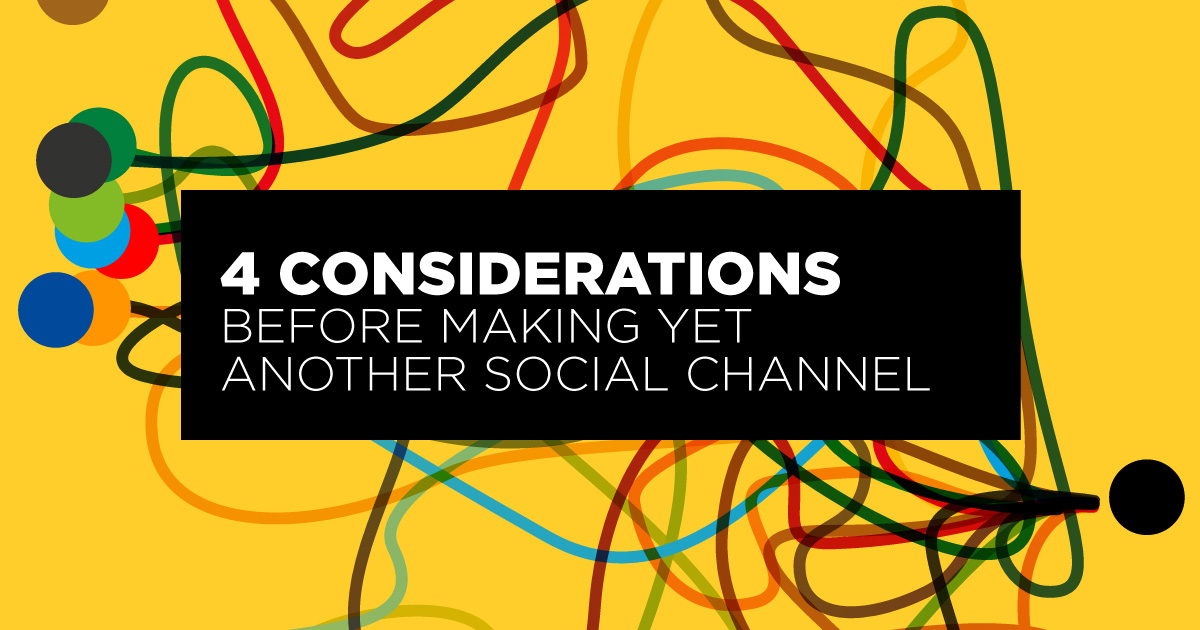Multiple locations. Multiple products. Multiple divisions or practice areas. Multiple campaigns or initiatives. More often than not, these are the types of things that lead to multiple branded social media channels. But should they?
The more complex your organization becomes, the more difficult it can be to define your brand and ensure that customers and stakeholders understand what you do, no matter the medium. On social media, where accounts are often easier to create than they are to maintain, this problem can be even more pronounced.
If you’re thinking about creating a new branded property or if it’s time to take inventory of your current channels, here are 4 diagnostic questions to determine whether a new channel will bring value:
How will this channel impact my search visibility on this platform?
The more profiles you have, particularly on a single platform, the more confusing it can be for potential new followers to find the content that they want. If the new profile will muddy the waters around which account to follow for what information, reconsider it. If you can’t think of a way to name an additional profile that makes its focus immediately evident, how much direction will the content on that channel have? These are activities that undermine your brand.
Do we have enough content and resources to maintain this channel long-term?
Social channels are designed to convey a brand identity long-term. It takes time and care to build a following and engagement, and that means having a steady stream of content and an engaged team to interact with followers. Avoid dedicated channels for short-term initiatives where the momentum will peter out in a matter of weeks or months. When considering a new channel for a specific location or practice area, honestly evaluate if you’ll be able to populate those channels with an optimal cadence of unique content long-term.
Am I trying to reach a different core audience than those on my existing channels?
Audience should always be at the center of your social media strategy. The best social media is just that, social – it’s a conversation with real people online. Those real people don’t always organize themselves into conversations the same way that we would organize our company. Many times I’ve seen two different divisions at a company whose work appeals to audiences with clear demographic or psychographic overlaps, but they each want their own social channels. This is a waste of resources, it’s confusing to the follower, and the content on each channel suffers because you’re only talking about half of the story. Give the follower what they want, an account that’s genuinely interesting to the audience.
Is there a platform feature that would better accomplish my goals than a new channel?
Social media companies themselves have become complex organizations – they understand your struggles and they’ve developed tools and resources to help you create a logical social presence with strong content that appeals to your audience. They know that doing so makes the platforms better for everyone. So ask yourself, am I creating a profile to do a hashtag’s job? Am I using Facebook Locations correctly? Do I need a whole profile or will a series of amplified dark posts do? Should this content even live on a branded profile or is it more appropriate to, for example, an executive’s social media presence?
Overall, social media is most effective when it is governed by a strategy that puts audience at the center and when everyone who communicates about your company online adheres to clear guidelines, just as they would when visually representing your brand. Product innovations, acquisitions, franchisees, important campaigns and events, and even key executive hires can all cause your company’s social footprint to grow faster than your strategy evolves.
Is now the right time to rethink your strategy and refocus on your audience? If so, drop me a line at [email protected]


